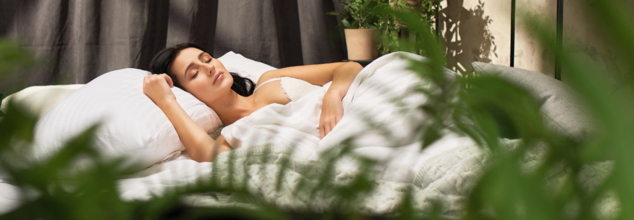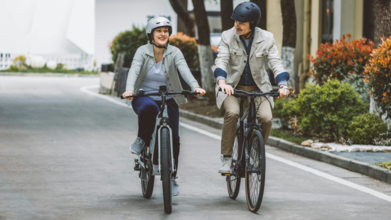- Health Conditions A-Z
- Health & Wellness
- Nutrition
- Fitness
- Health News
- Ayurveda
- Videos
- Medicine A-Z
- Parenting
- Web Stories
Bedtime Yoga Poses That Can Help You Fall Asleep Faster

After a long day of work, the best way to wind-down is by resting on your bed. However, many people still struggle to fall asleep, regardless of how tired they are. It could be because they are too stressed, anxious or experiencing an imbalanced circadian rhythm, which means their body clock makes it difficult for them to fall asleep at night.
Practicing yoga before bed can be an excellent way to let go of daily stress, both mental and physical, preparing you for a night of peaceful, deep sleep. Adding a gentle yoga routine to your evening can significantly improve how well and how long you sleep. This is especially helpful for those who sleep lightly, struggle with insomnia, or have limited time for rest.
Before You Start Your Bedtime Yoga
There are very few downsides to doing yoga before bed, as long as you practice safely. If even gentle movements seem to make you feel more awake, you might prefer meditation or breathing exercises instead. Your body might feel more flexible later in the day, so be sure to use your muscle strength to support your stretches and avoid pushing too hard. Always talk to your doctor before starting any new exercise, especially if you have health concerns or injuries.
Legs-up-the-Wall
Sit with one side against a wall, then swing your legs up the wall as you lie on your back, getting your hips close to the wall. Rest your arms comfortably. Focus on your breath and let go of tension. Hold for up to 5 minutes.
Reclined Butterfly
From a seated position, press the soles of your feet together and let your knees open out to the sides. Lie down on your back with your hands in a comfortable position. This calming pose helps quiet your nervous system and reduce stress. Hold for up to 5 minutes.
Child's Pose
Starting from a tabletop position, gently sink your hips back towards your heels. You can keep your knees together or wide apart. Let your chest relax onto your thighs and release any tension in your spine. This pose is relaxing and stretches your spine. Stay for up to 5 minutes.
Corpse Pose
This restorative pose is typically done at the end of your practice. Lie on your mat or bed with your feet slightly wider than your hips. Align your head, neck, and spine. Focus on your breath as you completely relax your body, allowing it to feel heavy. Stay in this position for up to 15 minutes.
Yoga Nidra
Yoga nidra is a guided meditation that helps improve sleep, reduce stress, and promote deep relaxation. You lie down, breathe deeply, and follow verbal instructions that calm your mind and release tension throughout your body.
Dwayne Johnson Unrecognizable New Look Leaves Fans Shocked, How The Rock Dropped 60 Pounds During Weight Loss Transformation

Credits: Venice Film Festival/Instagram
Dwayne “The Rock” Johnson has always been synonymous with strength, charisma, and an iconic muscular frame. But this week, fans barely recognized him. At 53, the actor unveiled a dramatically slimmer look while promoting his latest film, The Smashing Machine, leaving social media buzzing. Dropping an astonishing 60 pounds for his role as MMA champion Mark Kerr, Johnson’s transformation has sparked curiosity, how did one of Hollywood’s most ripped stars achieve such a drastic change and could it really be done safely? From diet tweaks to intense training, this transformation is surely a masterclass in discipline, science, and sheer determination.
From his WWE wrestling days to blockbuster hits like Fast & Furious and Black Adam, his signature look has been about size, strength, and power. But when he stepped onto the red carpet at the 82nd Venice International Film Festival, fans were stunned. Johnson, 53, appeared dramatically slimmer, having shed close to 60 pounds for his role in The Smashing Machine, a biopic about MMA legend Mark Kerr.
Clad in a sharp double-breasted suit and subtle glasses, Johnson looked nearly unrecognizable. Social media lit up with reactions ranging from admiration to disbelief. “The Rock turned into a pebble,” one fan quipped on X, while others speculated whether Hollywood’s latest weight-loss trend—injectables like Ozempic or Mounjaro played a role.
So how did the world’s most famous action star pull off such a radical transformation?
Dwayne Johnson Weight Loss: The Acting Role That Sparked a Transformation
The Smashing Machine, tells the turbulent story of Mark Kerr, a former NCAA wrestling champion; to do justice to Kerr’s complicated journey, Johnson didn’t just rely on prosthetics and wigs. He physically reshaped his body to mirror the leaner, battle-worn frame of an MMA fighter from the late 1990s. Speaking at Venice, Johnson admitted:
“This transformation was something I was really hungry to do. I’ve been fortunate in my career, but there was a little voice inside me that said, ‘What if I could do more?’”
How Did Dwayne Johnson Lost 60 Pounds?
Dropping 60 pounds is not a casual feat, especially for someone with Johnson’s naturally muscular build. It requires precision, planning, and science-backed strategies. Here’s a breakdown of what likely fueled his transformation:
1. A New Approach to Nutrition
Johnson has long been known for his intense, protein-rich “cheat meals” and high-calorie fueling. But slimming down for The Smashing Machine would have meant rethinking everything.
Caloric Deficit: To lose weight, he would have needed to burn more calories than he consumed daily. Reports suggest that his intake was strategically lowered while still supporting performance and energy.
Lean Proteins: While reducing muscle bulk, protein remains essential for muscle maintenance. Sources like grilled fish, egg whites, and lean chicken likely became staples.
Lower Carbs, Smarter Fats: Instead of bulking carbs, Johnson likely shifted toward complex carbs (like sweet potatoes and oats) and healthy fats (avocados, olive oil, nuts).
Hydration and Water Manipulation: A technique Johnson previously described during Black Adam prep. Adjusting water and sodium intake helps achieve a leaner, tighter look.
2. Training Like a Fighter, Not a Bodybuilder
Unlike superheroes or action roles that required maximum size, portraying Kerr demanded a more athletic, fight-ready build. Johnson’s training likely included:
Functional Strength Workouts: More bodyweight exercises, compound lifts, and fight-specific movements rather than sheer heavy lifting.
Cardio Conditioning: Interval training, long sessions of steady-state cardio, and possibly combat drills to replicate an MMA fighter’s stamina.
Mobility & Agility Training: Essential for replicating Kerr’s fighting style and reducing the risk of injury at 53.
Did Dwayne Johnson Use Ozempic or Fat-Loss Injections?
The internet buzzed with speculation about whether Johnson joined the list of celebrities turning to medications like Ozempic or Mounjaro, designed for diabetes but widely used for rapid weight loss.
There’s no confirmation from Johnson himself, and given his history of meticulous training regimens and diet transparency, it seems more plausible that his transformation was the result of strict lifestyle changes rather than pharmaceutical shortcuts.
Still, experts note that rapid and dramatic changes like this are usually only sustainable under professional supervision something Johnson has access to with his longtime trainer, Dave Rienzi.
This isn’t the first time Johnson has dramatically altered his physique for a role. For Black Adam (2022), he revealed how he worked “harder than ever” on dieting and training, manipulating sodium and water retention to achieve a superhero’s shredded frame.
The difference this time? Instead of aiming for mass and density, he trimmed down to reflect vulnerability, endurance, and realism. It’s a striking reminder that body transformations in Hollywood aren’t always about getting bigger—they’re about embodying a character.
Why Are Celebrity Weight Loss Transformations Becoming Popular?
Johnson’s transformation adds fuel to the ongoing discussion about how actors reshape their bodies for roles. Christian Bale, Matthew McConaughey, and Joaquin Phoenix all underwent dramatic shifts for character authenticity. But for Johnson a man defined by his physique it’s particularly startling.
His leaner frame also resonates with broader health conversation and the possible use of weight loss injections to transform into a leaner more "fitter" body. With obesity rates soaring and plant-based diets, intermittent fasting, and medical interventions gaining traction, fans are asking whether their favorite stars are adopting the same tools everyday people use—or something far more extreme.
Fitness Lessons You Can Apply To Your Journey
Dwayne Johnson’s new look may be for a role, but it underscores timeless lessons about health and body transformation:
- Significant weight changes require discipline, nutrition, and tailored exercise.
- Quick fixes, like weight-loss injections, remain controversial and should be supervised by medical professionals.
Even at 53, with the right guidance, it’s possible to reshape your body dramatically though sustainability depends on balance, not extremes.
Johnson has proven once again that his career is about more than action-hero brawn. His latest transformation shows he’s still willing to push physical and emotional limits to tell a story reminding fans that even “The Rock” is capable of change.
Zone Zero Workouts: Why Barely Exercising Could Improve Your Health And Longevity

Credits: Canva
When you hear the word exercise, your mind probably jumps to images of sweat-covered gyms, thudding treadmills, and high-intensity interval training. But what if the most overlooked type of movement—the kind that doesn't really feel like exercise at all—had incredible health benefits? Welcome to "zone zero" exercise, a strategy that flips conventional fitness wisdom on its head.
Zone zero is very low-intensity activity, slower and more relaxed than most fitness trackers would call zone one. It's activity so relaxed that you could talk easily the whole time. It's the opposite of stressing yourself to the limit: a walk around the block, some gentle yoga movement, stretching waiting for your coffee, or even light gardening. Athough it looks simple, zone zero can enhance health indicators, promote mental health, and even provide for longevity.
What are Zone Zero Workouts?
In endurance training, heart rate zones are used to organize workouts. Zone one is generally around 50-60% of your maximum heart rate—a slow, aerobic pace. Zone zero falls even lower, usually just above complete inactivity. Sports scientists argue whether it should be considered its own category, but its idea has drawn attention because it is so accessible and may have benefits.
Zone zero cares less about performance metrics and more about sustainability and consistency. It reminds us that it is better to move, albeit slowly, than to sit. In a world of sedentary lifestyle and intense fitness culture, the slow pace of zone zero provides an alternative, more sustainable way.
Zone Zero: Does Science Support Moving Slowly?
Zone zero advantages go beyond convenience. Research indicates even small amounts of physical activity can increase circulation, stabilize blood sugar, and promote mental health. Slow motion stimulates glucose uptake in muscles after eating, reducing the likelihood of insulin resistance and type 2 diabetes.
Light exercise also accesses fat stores for energy more efficiently than high-intensity workouts, which depend so much on glucose. A leisurely walk, or even standing at work, can slowly lower body fat while improving cardiovascular health.
Recovery is another significant benefit. Intensive training requires rest to rebuild muscles and restore energy. Zone zero offers a restful alternative. It melts stress and tension without draining energy resources, making it suitable for working professionals or family and work-committed individuals.
Mental Health and Consistency
Perhaps the most underappreciated aspect of zone zero is its mental health benefits. Low-intensity activity promotes mindfulness, alleviates stress, and helps regulate mood. It also helps build habits. Individuals are more likely to maintain a practice that is low-stress and feels accomplished, translating to compounded dividends: improved sleep, enhanced life satisfaction, and decreased risk of chronic illness.
Even on stressful days or lazy workdays, zone zero enables one to stay active. Small actions, such as dog walking, standing over a cup of coffee while reading emails, or a leisurely post-lunch walk, can, over time, change the mood, energy, and overall health.
Does Zone Zero Fit in 'Busy' Modern Lifestyle?
For some, fitness guidance can be overwhelming: steps, intensity, frequency. Zone zero makes it easy. It's about incorporating movement into daily life organically. Long periods of sitting are associated with higher health risks, even among people who do vigorous exercise sporadically. Regular, low-key activity can counteract these risks and supplement more intense exercise.
For athletes, zone zero provides a strategic advantage. Scientists have found that faster marathon runners spend much of their race in low-intensity zones, becoming endurance-building without exhausting themselves. Low-intensity movement might help recovery, rebuild heart structure, or prime slow-twitch muscle fibers, all leading to improved performance over time.
Can Anyone Do Zone Zero Exercise?
Zone zero is not reserved for elite athletes or those in their golden years; it can be tailored for anyone. Its greatness is accessibility. No equipment, heart rate monitors, or strict regimens are necessary, unlike traditional training. Anyone can weave gentle movement into the day and gain both acute and chronic health benefits.
Whether it's a retiree wanting to stay mobile, a working professional needing stress relief, or an injury returnee, zone zero provides a low-barrier way to get into regular exercise. Its focus on sustainability ensures movement becomes a lifelong practice and not a temporary commitment.
How to Add Zone Zero Exercise In Your Workout?
Following are practical suggestions for integrating zone zero in everyday life:
Gentle Walking: A leisurely neighborhood walk, short post-meal walks, or walking on the phone.
Easy Yoga or Stretching: Add stretches to your morning and evening routine without exhausting yourself.
Gardening and Yard Work: Light digging, planting, or weeding is low-intensity exercise.
Standing Activities: Employ standing desks or switch between sitting and standing while working.
Household Chores: Cleaning, dusting, or tidying up keeps your body in motion without structured exercise.
Casual Cycling: A slow bike ride at a speed that permits normal conversation.
Active Breaks: Brief, slow walks during work breaks to interrupt extended periods of sitting.
Recreational Hobbies: Light dancing, tai chi, or easy play with children or pets.
Zone zero contradicts conventional notions of how exercise "ought" to be. Its merit is not in intensity but in regularity, accessibility, and accumulation of benefits. Even small, persistent movement can boost circulation, stabilize blood sugar, improve mental well-being, and lead to longevity.
In a culture that values efficiency and peak performance, the idea of flowing slowly may seem contradictory. But growing evidence demonstrates that on occasion the easiest, slowest way is the one most likely to have significant implications for health, fitness, and well-being.
Cardiologist Warns “You Don’t Have One Heart... But 2”: How This ‘Silent’ Second Heart Could Change Your Health

(Credit-Canva)
Our hearts works very hard to make sure we have the energy and strength to do everything we need. However, as gracious our organs are to us, most of us are not as helpful back to it. Whether it is eating junk food, not exercising, sleeping late etc. However, did you know, your heart is not the only one bearing the burden? You also have another heart in your body contributing to your health.
Heart transplant cardiologist Dr. Dmitry Yaranov calls your calf muscles your "second heart" for a very good reason. When you move your legs, these muscles squeeze and relax, which helps push blood back up toward your main heart.
This pumping action is essential for good circulation throughout your body. Without it, blood can pool in your lower legs, making it harder for your heart to work. By keeping your calf muscles strong, you help your body's entire circulatory system run smoothly, which can prevent problems like dangerous blood clots.
How Your ‘Sitting’ Lifestyle Is Killing Your Heart
Our modern lives often involve a lot of sitting, which is a big problem for our calves and our hearts. When we don't use our calf muscles, they weaken and lose their ability to pump blood effectively.
Dr. Yaranov warns that this forces your main heart to work much harder to circulate blood on its own. Over time, this extra strain can cause circulation to slow down, leading to swelling in your legs, high blood pressure, and a much higher risk of heart failure. No pill can replace the natural, powerful benefits of simply moving your body.
Simple Ways to Keep Your Calves Strong
The good news is that you can easily strengthen your calf muscles without a gym. Dr. Yaranov suggests simple changes to your daily routine. Try to walk every day to get your blood flowing.
You can also do calf raises while you're sitting at your desk or waiting in line at the grocery store. Whenever possible, choose to take the stairs instead of the elevator. These small, consistent actions will help keep your "second heart" strong and healthy for life, which in turn protects your main heart.
Calf Exercises You Can Do At Home
Calf Raises
Stand with your feet flat on the ground. Slowly lift your heels as high as you can, balancing on your toes, then lower yourself back down with control. Repeat for several repetitions to build strength.
Single Leg Calf Raise
Stand on one leg, using a chair or wall for balance. Lift your heel as high as possible, then lower it back down slowly. This variation helps improve your balance and builds strength one leg at a time.
Standing Calf Stretch
Stand a few feet from a wall and place your hands on it. Step one foot back and lean forward, keeping your back heel on the floor to feel a deep stretch in your calf. Hold for 30 seconds.
Dumbbell Calf Raise
Hold a dumbbell in each hand. Stand with your feet flat on the ground. Lift your heels and rise up onto your toes. Squeeze your calf muscles at the top before slowly lowering yourself back down.
Seated Calf Raise
Sit on a chair and place your feet flat on the floor. Place a heavy book or a dumbbell on your knees for weight. Lift your heels as high as you can, then slowly lower them for a controlled movement.
© 2024 Bennett, Coleman & Company Limited

